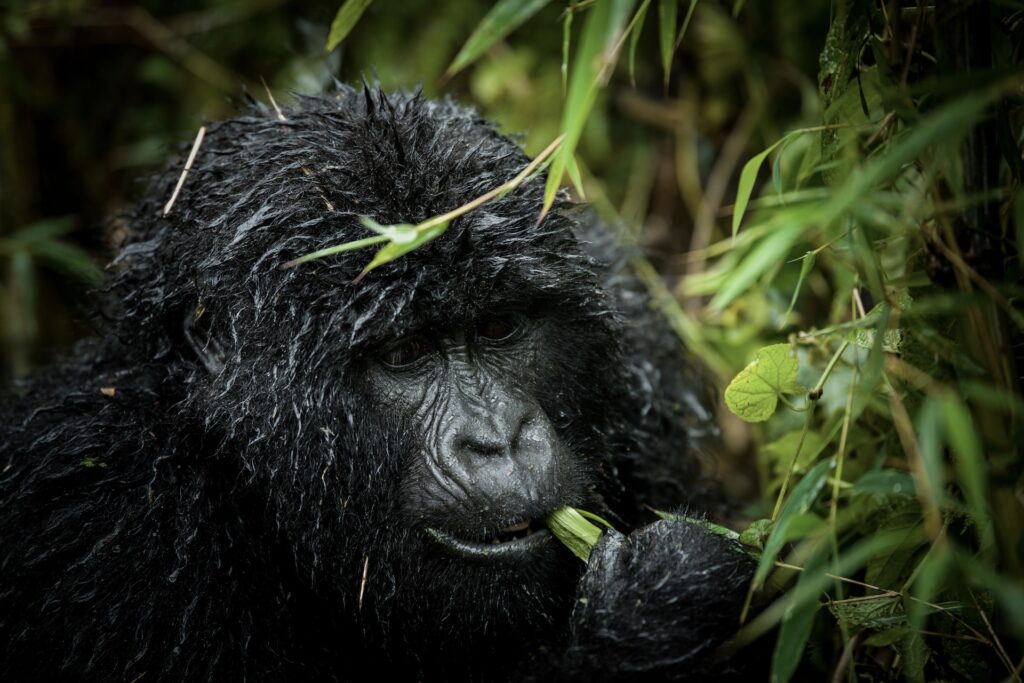Bwindi impenetrable national park
Bwindi Impenetrable National Park.
Bwindi impenetrable national park is a dense, misty and majestic forest located in southwestern Uganda, home to over 468 endangered mountain gorillas, roughly half of world’s population. The park’s 331 square kilometers of rugged terrain, steep hills and valley are covered with lush vegetation, including bamboo, ferns and ancient trees, creating a prime habitat for the mountain gorillas and other wildlife such as monkeys, numerous bird species and among others. The park as unique landscape, shaped by volcanic activity and erosion, with narrow ridges, deep valleys and sparkling waterfalls, making it a challenging yet wonderful beautiful safari destination for gorilla trekking and exploration

Attractions in Bwindi impenetrable national park.
Mountain gorillas.
The mountain gorillas in Bwindi impenetrable forest national park are sub species of the eastern gorillas, characterized by thick fur, broad chests and gentle eyes. They live in stable, different groups, led by dormant silver back males and feed on leaves, shoots and fruits. Bwindi’s gorillas are habituated to human presence, allowing for gorilla trekking, and they share 98% DNA with human beings, playful antics, and intelligent behavior. With approximately 468 gorillas, Bwindi’s population is divided into over 20 groups offering an unforgettable safari experience for trekkers and researchers alike.
Animal species.
Bwindi impenetrable national is a home to a diverse array of animal species including 120 mammals, 348 bird species, 220 butterfly species, and over 27 species of reptiles and amphibians. In addition to the primates like baboons, monkeys as well as larger mammals like elephants, buffaloes, and antelopes and among others. The park’s dense forest also harbors smaller creatures like bush pigs, duikers, rodents and others.
Bird species.
Bwindi impenetrable national park is a birdwatcher’s paradise hosting an incredible 348 species of birds, representing 10% of Uganda’s total bird population. The park’s diverse bird species includes iconic species like the African Green Broadbill, Black-billed Turaco, Shelley’s Crimsonwing as well as hornbills, sunbirds, bee-eaters and among others. The park’s forest is a home to rare and endemic species like the short-tailed Warbler and the Blue-headed Sunbird, while its undergrowth harbors skulking birds like the Rusty-breasted Wren and the Black-faced Rufous Warbler. With its unique combination of montane and lowland species.
Things to do in Bwindi impenetrable national park.
Gorilla trekking in Bwindi Impenetrable national park.
Gorilla trekking safari in Bwindi impenetrable national park involves hiking through dense forest to observe forest to observe endangered mountain gorillas in their natural habitat. Guided treks led by experienced rangers, move in steep terrain and thick vegetation to reach one of the park’s 20 habituated gorilla groups, allowing for rare and wonderful encounter with these great creatures. Trekkers spend up to one hour observing their behavior and taking pictures, creating an unforgettable experience safari breathtaking scenery.

Gorilla habituation in Bwindi Impenetrable national park.
Gorilla habituation in Bwindi impenetrable national park is a process of gradually introducing mountain gorillas to human presence, allowing them to become comfortable with trekkers. Skilled rangers and researchers spend years habituating specific gorilla groups, starting with occasional visits and gradually increasing frequency and duration. This gentle process helps gorillas become tolerant of humans, enabling safe and enjoyable trekking experiences while minimizing disruption to their natural behavior and habitat. Habituation also facilities valuable research and conservation efforts, ensuring the long-term protection of these endangered animals.

Guided nature walks in Bwindi Impenetrable national park.
Guided nature walks in Bwindi impenetrable national park offers a interesting and immersive safari experience allowing visitors to explore the forest’s diverse flora and fauna alongside leisurely walks traverse scenic trails, revealing hidden colorful bird species, as guides share insights into the forest’s unique ecosystem, ancient trees. With options ranging from easy walks to more challenging hikes, nature walks cater to various interests and fitness levels, providing a serene and enriching complement to gorilla trekking.

Bird watching in Bwindi impenetrable national park.
Bird watching safari in Bwindi Impenetrable national park is a thrilling safari experience with over 348 species recorded, with many Albertine Rift endemics. Guided nature walks or hikes with experienced birding guides reveal a kaleidoscope of colours and sounds, from the iconic African Green Broadbill to the rare Shelley’s Crimsonwing. The park’s varied habitats, from montane to lowland forests, attract a wide range of avifauna, making it a paradise for bird enthusiasts and photographers, with opportunities to spot rare and sought-after species amidst breathtaking scenery.

Batwa cultural tours in Bwindi impenetrable national park.
Batwa cultural tour in Bwindi impenetrable national park offers a unique opportunity to explore the traditional lifestyle and heritage of the Batwa people, an indigenous community that once lived in the forest. Guided by Batwa guides, visitors learn about their ancient hunting and gathering skills, medicinal plant use, and cultural practices, while exploring the forest and its resources through their eyes. The tour also includes a visit to the community, where guests can engage with locals, witness traditional dances and music, and support community development projects, providing a fascinating insight into the history and culture of the region’s original inhabitants.

Best time to visit Bwindi Impenetrable national park.
The best time to visit Bwindi Impenetrable national park is during the dry or peak season from June to August and December to February, when the weather is mild and sunny, making it ideal for gorilla trekking safari and other activities. These months offer clear skies, dry trails and minimal rainfall, increasing the chances of spotting gorillas and other wildlife. However, the park can be visited year-around, and the wet season (March to May and September to November) can be beneficial for bird watching, photography with lush vegetation and fewer tourists making it a more peaceful and serene safari experience.
